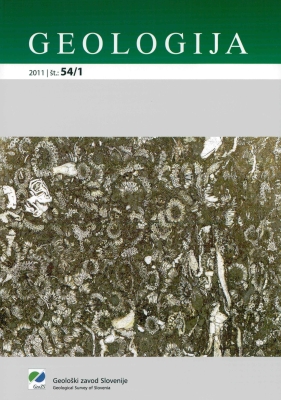SEM/EDS analiza tal in prežganih koščkov keramike iz nekdanjih žgalnic živosrebrove rude na Idrijskem
DOI:
https://doi.org/10.5474/geologija.2011.002Povzetek
Na območjih nekdanjih žgalnic v okolici Idrije, ki so jih uporabljali za žganje živosrebrove rude v prvih 150 letih delovanja rudnika, najdemo številne ostanke glinenih žgalniških posod. Odlomki žgalniških posod ležijo tik pod površinskim organskim horizontom in segajo na nekaterih delih več kot 1 meter globoko; pogosto so na notranji strani prekriti z rdečimi (cinabarit) in črnimi (metacinabarit) oprhi. SEM/EDS analiza tal in prežganih koščkov keramike iz žgalniških območji Pšenk in Frbejžene trate, je bila uporabljena za opredelitev nosilcev živega srebra v izbranih vzorčnih sredstvih. Ugotovljeno je bilo, da Hg v obravnavanih vzorcih nastopa predvsem v obliki živosrebrovega sulfida HgS. Analiza prežganih koščkov keramike je pokazala številne obloge HgS na površini, ki se pojavljajo kot skorjasti skupki na osnovi ali kot individualna zrna. Nekatera lepo oblikovana zrna z nakazano strukturo dosežejo velikost do 200 μm. V vzorcih tal in SOM je se HgS pojavlja predvsem v obliki zelo drobnih razpršenih delcev na površini glinenih in drugih mineralov. Številni zelo drobni delci HgS brez dobro izražene strukture, vključeni v talne skupke in prekriti s tankimi glinenimi prevlekami, nakazujejo možen obstoj drugih vezav med živim srebrom in žveplom razen kristalnega HgS (živo srebro vezano na faze vsebujoče žveplo).Prenosi
Kako citirati
Teršič, T. (2011). SEM/EDS analiza tal in prežganih koščkov keramike iz nekdanjih žgalnic živosrebrove rude na Idrijskem. Geologija, 54(1), 31–40. https://doi.org/10.5474/geologija.2011.002
Številka
Rubrika
Članki

